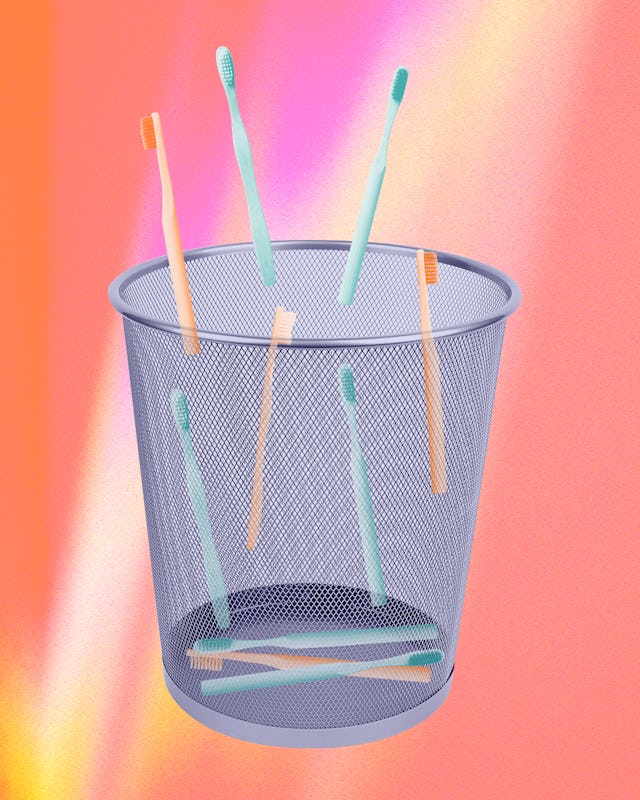What Personal Items Should You Toss After COVID? A Doctor Weighs In
Find out the fate of your toothbrush, makeup, and more.

If it seems like everyone you know has COVID right now, you can blame it on the highly infectious Omicron subvariants, which continue to dominate as COVID-related public health measures like indoor mask-wearing have all but dissipated in most states. Even though plenty of people are done with the virus, the virus is proving it's far from done with us. And the current wave of infections — which seems to be an undercount, if those who test positive at home aren't reporting their status — is proof of that. That said, if you are currently battling COVID-19 or are on the road to recovery, you might be curious about how to protect your family and those who enter your home in the days and weeks post-COVID.
Thankfully, we're no longer in the "Lysol your grocery bags and air out your Amazon boxes in the garage" phase of the pandemic, since the Centers for Disease Control and Prevention (CDC) has noted that disinfecting surfaces is "not typically necessary" in reducing COVID risk.
But you might be wondering whether or not your personal items, such as your toothbrush, contact lenses, beauty products, and the like, are completely safe and COVID-free after you've recovered. To find out what's safe just to sanitize and what you should toss, Scary Mommy asked Chicago-based internal medicine physician Dr. Vivek Cherian.
How proactive should you be about disinfecting personal items?
Cherian tells Scary Mommy that it's good practice to disinfect commonly used household items after any infectious illness, whether COVID or your garden-variety cold, flu, or stomach bug. However, the chance of reinfecting yourself or passing along COVID to someone else through surface touch is rare, even amid the more contagious strains.
"When it comes to COVID-19, including the variety of variants that have emerged, we know the virus is not particularly stable on surfaces," says Cherian. "According to the CDC, the virus can survive up to 3 days on a nonporous surface," including glass, plastics, metals, and varnished wood — aka the vast majority of what you touch on a daily basis. So, giving things a good squeaky cleaning isn't a bad idea, but you won't need to fully fumigate your home after a bout of COVID.
Should you throw away your toothbrush post-COVID?
According to Cherian, there are some personal items you might want to toss or clean extremely thoroughly after you've recovered (or around 10 days after your positive test). "It's always good practice to change your toothbrush after any illness, including COVID-19. This is true in general but even more so the case if you share a toothbrush holder with another individual," he explains.
You should be replacing your toothbrush every three months, but after COVID, it's a good idea to start anew.
What about beauty products?
When it comes to toiletries and makeup, you probably have little to worry about, even if it's a shared household item like soaps and cleansers. "In general, products that are dispensed without direct contact through a tube such as cleansers, shampoos, or foundation pumps are relatively safe, though you may want to consider cleaning the surfaces with alcohol," says Cherian. "Even products that you may dip your finger into and have direct contact with, such as moisturizers, eye shadows, or lipsticks, do not need to be thrown out.”
Cherian continues, “It is also important to remember that cosmetic products do not have an unlimited shelf life. Oftentimes, they contain preservatives and antioxidants, and using these products can reintroduce various microorganisms and oxygen to the product," which breaks it down over time. "Preservatives can be effective at keeping harmful organisms at bay; however, over time, they lose efficacy," which means there can be icky bacteria lurking in those lipsticks you've held onto for the better part of the last decade. (No judgment, just means it's time to splurge on something new!)
"Remember that there is a lifespan associated with a virus, and over a period of time (depending on the surface), it will die," adds Cherian. "If you want to be completely safe after an infection, let beauty products sit around for 10 days before using them again — there is a good chance that any illness-causing germs would have disappeared by then."
"Also, in general, it is important to remember not to share your beauty products with another person," says Cherian. "For yourself, the chance of reinfection by the exact same virus variant is quite low, especially as you have been exposed to it before. However, this is not necessarily the case with another individual" who hasn't previously been exposed to COVID.
Should you wear contacts with COVID? Or use existing contacts post-COVID?
You might want to stick to wearing your glasses until you've recovered, says Cherian. If you have worn contacts during your illness, though, don't fret: "With regards to contact lenses, there's really no data to support the potential transmission of COVID-19 through ocular mucous membranes," aka your eyeballs.
"In general for contact lens wearers, the absolute safest option to decrease the risk of any contact lens-related infection is to use daily disposable lenses, or lenses that you throw in the garbage after wearing for one day,” advises Cherian, emphasizing that you should make sure to thoroughly wash your hands before and after use.
If you do switch to glasses, he adds, "COVID-19 can remain on hard surfaces potentially for hours to days and can transfer from your hands to your glasses, so make sure you clean them regularly when using them."
This article was originally published on